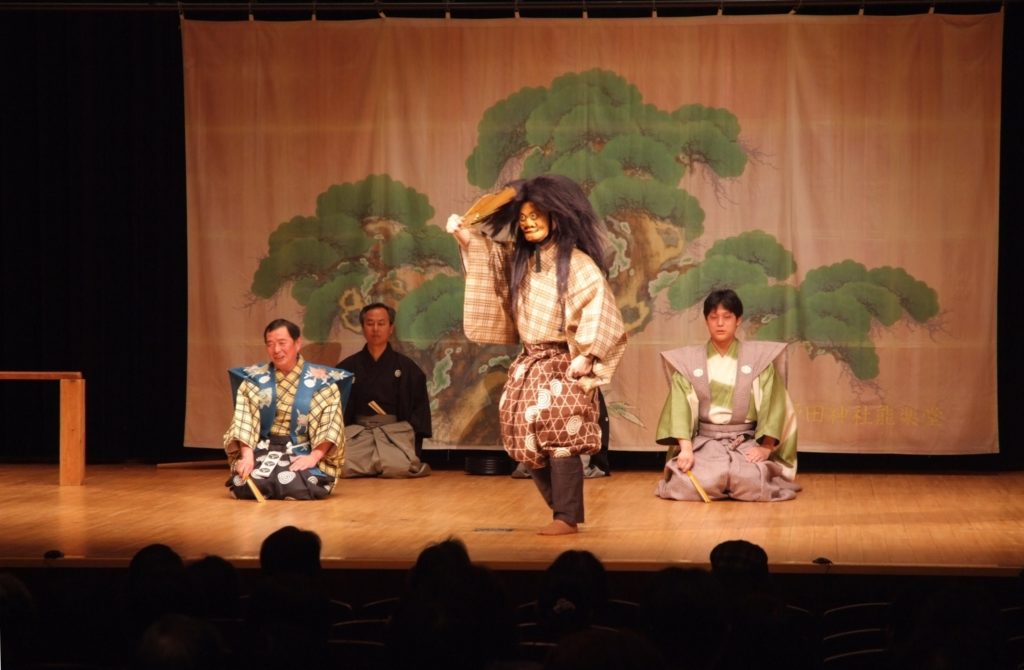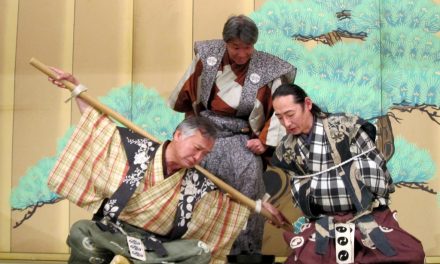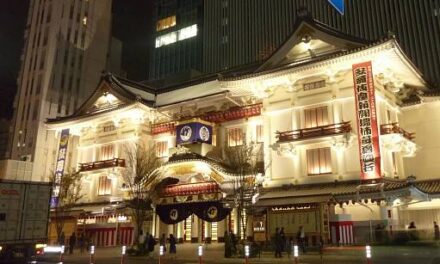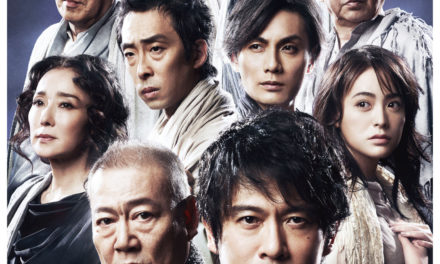Today, if you bring up the topic of the traditional Japanese comedic performing art, kyōgen, chances are the conversation you will have will revolve around either the activities of the professional Ōkura (大蔵) or Izumi (和泉) schools. Kyōgen’s third school, the Sagi school (鷺), is presumed to have died out in the Meiji period (1868-1912) with the death of its final iemoto (school grand master), Sagi Gonnojō, in 1895.
However, Sagi kyōgen did not die. It continued thanks the to efforts of a lineage of non-professional performers and supporting community members in Yamaguchi City (Yamaguchi Prefecture) and Sadogashima Island (Niigata Prefecture). Yet, because these groups do not operate under the accepted traditional system of transmission, which requires an iemoto, their contributions, as well as Sagi kyōgen’s history and activity, has remained obscured.
Before going any further, it may be useful to provide a little background on kyōgen and the iemoto system. Kyōgen’s origins are tied to its more austere cousin, noh, both forms being firmly established, artistically, by the start of the Murmomachi period (1392-1573). While noh tells serious stories about heroes and ghosts, kyōgen tells humorous tales about everyday people during Japan’s medieval period. Both were collectively known as sarugaku up until the Meiji period (1868-1912) and kyōgen plays before the modern era were always part of a day’s noh program, serving as a kind of palate cleanser. Today it is possible to attend kyōgen performances, both within the context of a noh performance or presented by themselves.

Koyakkuneri. Photo by the author. Yamaguchi Sagi kyogen, January 2016 From left to right: One boastful glue salesman (Fukushima Hisayoshi) and another (Moriwaki Ryō) test each other’s product by attaching their product to their own heads and having a glue tug-of-war.
Describing what kind of comedy kyōgen is, is…complicated. Is it farce? Maybe. Is it satire? Could be. Is it parody? Sometimes. It is for this reason that I’d like to borrow from June Compton, and say the best way to describe what kyōgen is, is by using a Japanese word: gekokujō (下克上). This word might best be translated as “inversion.” I think this act is at the heart of every kyōgen play, be it about wily servants tricking their master or a group of mushrooms overtaking a quack priest charged with getting rid of them.
The point is, kyōgen is almost always about the little guy getting his due. Everyone has been the little guy at some point and so kyōgen is truly a comedy for, by, and of, the people.
As for the iemoto system, it was utilized as far back as the Heian period (794-1195), but was adopted by noh and kyōgen in the Tokugawa period (1603-1868), when they became shikigaku, or ceremonial arts of the shogun’s government. The kyōgen schools recognized were the Ōkura and Sagi schools, with the Izumi school operating primarily through support outside of the government. The system recognizes a single male as the head of a school of only male performers. Today, an iemoto serves as director of a school’s activities, is responsible for recognizing new members, and is allowed to revise plays and music. Typically, the iemoto system in noh and kyōgen is a system of inheritance via the first born son, but there are cases in which no male heir has been present or the first born male has decided not to continue as a performer.
Though Ōkura kyōgen has the oldest available written records and, assumedly, had higher status among the artists of the Edo era, it was the Sagi style of kyōgen that was the shogunate’s favorite. The school’s probable founder, Sagi Niemon Sōgen (1560-1650), had been a favorite performer of Toyotomi Hideoyoshi and Tokugawa Ieyasu prior to the establishment of the Tokugawa government and this preference certainly aided Niemon’s status when Ieyasu became shogun in 1603. Niemon and his nephew, Denemon (鷺伝右衛門) a sōke (宗家, family head) of the Sagi school’s branch family, subsequently became the top ranked kyōgen performers of the early Edo period. Sagi kyōgen activity was concentrated in Edo. However it was supported by various daimyo in Yamaguchi, Niigata, Yonezawa, Aizu, Kaga, Nagasu, Aba and Satsuma (Kobayashi, 4).

Tanuki Damashi. Courtesy of Yamaguchi Sagi kyogen Preservation Society, January 2015. From Left to Right, A Man (Yonemoto Bunmei) convinces a drunken Tanuki (Yonemoto Tarō) to dance, much to the delight of a Passerby (Suzuki Tarō).
Ōkura Toraaki’s 1651 text, the Waranbegusa, is perhaps our best picture of what Sagi kyōgen was like, stylistically, compared to Edo era Ōkura and Izumi school kyōgen. It also gives us a good idea of exactly what Niemon’s contemporaries thought of him. Toraaki criticizes Sagi kyōgen as being the most lackadaisical of the kyōgen schools in terms of performance, catering to the basest of tastes. He notes, in regards to Sagi kyōgen
“The kyōgen these days does not have a body, it is hectic, says nonsense, is meandering, and makes the lower class laugh, but the ones with taste cringe.” (Toraaki, 64)
While Toraaki abhorred Sagi performance style, the freedom Sagi kyōgen presented was likely appealing to the new government for a number of reasons. First, the early Tokugawa shoguns wanted to prove their new capital of Edo was just as cultured as Kyoto’s aristocratic court. However, there was one problem: the Tokugawas were rough around the edges. The establishment of noh and kyōgen as shikigaku brought the prestige and Sagi kyōgen, in particular, unlike the polished Ōkura school traditions, offered an approachable middle ground. It catered to Tokugawa’s less refined tastes, while enabling the regime to retain the bragging rights of patronizing a “high art.” Secondly, Sagi kyōgen’s youth gave the Tokugawa rulers agency in its development. Rather than simply fostering the preservation of an established style, the Tokugawa rulers could play an active part in making a high art that subscribed to and reflected their sensibilities.
With the transition from feudal government to parliamentary in the Meiji Period, art forms like noh and kyōgen, which previously relied on financial support from the government, had to find a new way to support themselves. Some actors endured, some quit entirely, others found new jobs in other art forms, and some tried to create new twists on old art forms. The “twist” angle is where Sagi kyōgen supposedly got into hot water. It is said that after Sagi kyōgen actor Namekawa Shosaburō taught kabuki actor, Ichikawa Danjurō IX, how to perform the kyōgen, Tsurigitsune in 1883, Sagi kyōgen actors were blacklisted by the kyōgen community for committing the unforgivable sin of revealing secret teachings to non-kyōgen actors.
However, there are no records to indicate any kind of official black-listing. In reality, while such horrors surely angered the kyōgen community, the school’s professional demise should be attributed to its eccentric last iemoto, Gonnojō, and a failure to establish new lines of performers. Gonnojō, who Kobayashi describes as “an oddball with wanderlust” (Kobayashi, 3), roamed around Japan, eventually being brought back to Tokyo by the head of the Kanze noh school, Kanze Kiyotaka. Gonnojō taught off and on and performed rarely, ultimately dying penniless in a hotel room, thus ending the professional Niemon line. The Denemon line’s professional demise is more tragic, with Denemon X, destitute and suffering from consumption, committing seppuku (ritual disemboweling) in his Tokyo home in 1882.
The poet Henry Wadsworth Longfellow famously said, “Into every life a little rain must fall” (The Rainy Day, 1842), and so it was with the Sagi school.
However, both Gonnojō and Denemon’s legacies were not eradicated in their deaths but rather continued through the work of artists, both male and female, in Sadogashima and Yamaguchi City. Their traditions continue today.

Busu. Mannomachi Sagi kyogen, September 2016 Taro Kaja (Mizuguchi Midori) and Jiro Kaja (Nakayama Chiyoko) attempt to get closer to a deadly poison they’ve been ordered to protect by fanning away the fumes. After discovering it is actually sugar, they gobble it up, much to the chagrin of their master. Photo by the author.
Research conducted by the Sado Sagi kyōgen Research Society (established in 1984) illustrates that professional Sagi kyōgen was practiced by local actors in Sadogashima (Niigata Prefecture) as early as 1825, with the actor Hanashi Gen’ai returning with a license to teach after studying in Edo with the Sagi iemoto Niemon XVI. Additionally, the last shogunal magistrate of Sadogashima, Mikawa Seikan, had been studying Sagi kyōgen in Edo prior to his appointment in Sadogashima and, after the transition to the Meiji period, continued the practice, taking on students himself and beginning the Sawane line. Later, in 1885, Tsuruma Heizo established the Mannomachi Line after studying with Gonnōjo. The Sawane line ended in 1969, but today the Mannomachi line remains with about 10 men and women performing Niemon style Sagi kyōgen.
Yamaguchi’s relationship with Sagi kyōgen is deeper, but curious. Sarugaku had a long history of activity in the Yamaguchi prefecture before the Edo period, dating back to the mid-1300s. While one would assume that this tradition, patronized almost exclusively by the Tokugawa shoguns, would receive a frosty reception from Tokugawa’s bitter rivals, the Yamaguchi Chōshū Clan, the exact opposite was true. Yamaguchi Prefectural University Professor and Sagi kyōgen scholar, Inada Hideo, suggests the reason for Sagi kyōgen flourishing in the post-Tokugawa Era is precisely because the Chōshū Clan’s deep affinity for the school made Sagi kyōgen an important part of local culture (Inada, 142).
Yamaguchi Sagi kyōgen begins with actor Shōsaku Shunnichi. Shōsaku, the second son of a Chōshū clan samurai, was born in 1816 and, by 1858, records indicate he was a student of Sagi Denemon X. Living in Ube in 1885, Shōsaku abdicated his status as a professional kyōgen actor. However, when Shōsaku was invited to perform at the newly constructed Noda Shrine’s Flagpole Raising Ceremony in 1886, his performance was so favorably received, he relocated to Yamaguchi City and began instructing a line of performers in Yamaguchi city that remains unbroken.

Catching Plovers. Courtesy of Yamaguchi Sagi kyogen Preservation Society, Centre College Tour, Kentucky, 2015. From left to right: Taro Kaja (Yonemoto Bunmei) is caught trying to pilfer sake for his master’s party by the sake shop owner (Yonemoto Tarō).
Among the Sagi kyōgen groups, the Yamaguchi actors are certainly the most prolific in terms of output today. Along with two annual scheduled productions, the group has performed an average of 20 shows per year since 2005. These shows range from privately scheduled events to public school appreciation performances and workshops. They have performed at Tokyo’s National Noh Theatre and for Japan’s Prince Akishino. While the group’s senior member, Kobayashi Eiji, no longer performs, he is still a source of knowledge for Yonemoto Bunmei, who leads weekly rehearsals along with his son, Tarō.
Tarō himself, a graduate of Tokyo University of the Arts (東京芸術大学), has studied Yamaguchi Sagi kyōgen since age 14 (20 years at this point) and leads a weekly kyōgen classroom for young people.
The group retains a strong relationship with Yamaguchi Prefectural University and Professor Inada is the Yamaguchi Preservation Society’s (founded in 1954) historian and expert on Denemon style performance techniques. Yamaguchi Sagi kyōgen was designated an Intangible Cultural Art of Yamaguchi Prefecture in 2007 and, more recently, in 2015 the group travelled to the US for the first time, to perform at Kentucky’s Centre College as part of the school’s Winter Plum Festival.
Video Caption: Shimizu Courtesy of Yamaguchi Sagi kyogen Preservation Society, Centre College Tour, Kentucky, 2015.
The question remains: If the art form has continued with an unbroken line and cultivated an artistic pedigree similar to its professional counterparts, what makes it different? In my mind, it is simply that Sagi kyōgen actors exist outside of the iemoto system. Intangible cultural Asset of Yamaguchi Prefecture, Yonemoto Bunmei recently explained Yamaguchi Sagi kyōgen’s current plight to me:
“We aren’t professionals, but we aren’t amateurs either. Amateurs do it as a hobby. For us, it is a second job. But we don’t get paid. It’s complicated.”
In other words, Sagi kyōgen is trapped in a limbo state.
If the iemoto system is a box, it is not to say that the artists who abide by its rules live in it. If anything, it is merely a construct that has been effectively utilized by a diverse group of talented artists looking to ensure their individual families’ artistic legacies. One might consider it a powerful union.
There is no denying that the iemoto system has facilitated the preservation of incredible artistry and produced superb actors. But unfortunately, it has also left little room for an art like Sagi kyōgen, historically trapped between professional and amateur worlds. What Sagi kyōgen offers is an example of what happens when you remove this artificial construct and instead focus on the art itself. How does a traditional performing art like kyōgen evolve? What are the external circumstances that play a role in its evolution? What role does gender play in kyōgen practice? How has amateur activity supported kyōgen’s development? What is the value of kyōgen in contemporary Japanese communities? How does it represent the contemporary Japanese citizen?
I believe wrestling with such perspectives opens up a wealth of exciting inquiries that can bring fresh attention to the professional traditional kyōgen world and provide a little dose of “comic inversion” for kyōgen’s unsung heroes.
REFERENCES
Compton, June. The kyōgen women: A Comparative Analysis and Classification of the Female Characters in Japan’s Classical Comedies. Diss. U Colorado: Boulder. 1997. Print.
Inada, Hideo. “Yamaguchi Ni Tsutawatta Sagi ryū kyōgen [Transmission of Sagi kyōgen
in Yamaguchi].” Daigakuteki Yamaguchi Gaido: Rekishi to bunka [University Guide to Yamaguchi: History and Culture]. Yamaguchi: Yamaguchi Prefectural University, 2011, pp. 141-153.
Inada, Hideo and Tarō Yonemoto. Yamaguchi Sagi ryū kyōgen hozonkai rokujū nen no Ayumi [Sixty Years of Progress in the Yamaguchi Sagi kyōgen Preservation Society]. Yamaguchi: Yamaguchi Sagi ryū hozonkai, 2015. Print.
Ikeda, Tetsuo. Sado no Sagi ryū kyōgen: Sono Denshōshitachi [Sado Sagi kyōgen: The Transmitters]. Mannomachi: Sado Sagi ryū kyōgen hozonkai, 1984. Print.
Kobayashi, Seki. Kyōgen-shi Kenkyū [Research of kyōgen History]. Tokyo: Wanyashotenkan. 1974. Print.
Kobayashi, Seki and Shinko Kagaya. “Kyōgen in the Postwar Era.” Asian Theatre Journal, vol. 24, no. 1, 2007, pp. 144–177.
Longfellow, Henry Wadsworth. “The Rainy Day.” Henry Wadsworth Website. www.henrylongfellow.org. Accessed on 20 January 2017.
Ōkura, Toraaki, and Ken Sasano. Waranbegusa. Tokyo: Iwanami Shoten, 1962. Print.
Sagi Kyōgen Kiroku Sakusei iinkai, comp. Yamaguchi Sagi-ryū Kyōgen Shiryō Shūsei (shoshi/kyōgenbon) [A Record of Yamaguchi Sagi kyōgen (bibliography and kyōgen collection)]. Vol. 1. Yamaguchi: Yamaguchi-shi Kyōiku Iinkai, 2001. Print.
This post was written by the author in their personal capacity.The opinions expressed in this article are the author’s own and do not reflect the view of The Theatre Times, their staff or collaborators.
This post was written by Alex Rogals.
The views expressed here belong to the author and do not necessarily reflect our views and opinions.
















